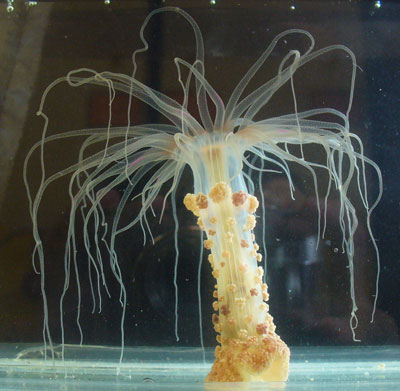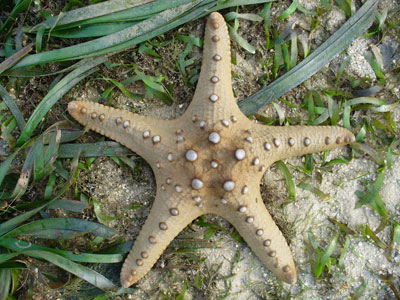Now she reveals a 'daughter' of hers, Alicia. And this is how she looks like.

As stunning (literally) as Cyrene herself, Alicia flows with grace and dresses well.

She even puts gloss on her lips, and has dyes of pink streaks!
This is actually a sea anemone, Alicia sp. As quoted from Dr. Daphne Fautin, an expert in sea anemones:
"WONDERFUL!!!! This is a member of Family Aliciidae, which is one of those on which my graduate student is concentrating. So there is another one for her to seek when we visit Singapore! And it is an addition to our growing list. It is probably Alicia, of which there are 2-3 known species that this might be. My student will be looking at type specimens during the next six months, so will soon have a very good idea of the features distinguishing each."
This particular anemone was found by someone (you know who you are. =D) during the recent trip to Cyrene Reef. This family of sea anemones are rare and they can sting fairly severely. At night, the anemone spreads its crown of tentacles and expands its stalk decorated with numerous distinct outgrowths called pseudotentacles. During the day, the tentacles and the stalk contract, and the animal looks like a mass of clustered berries. Hence, many people who see this animal during the day don't recognize it as an anemone.
Pseudotentacles usually have stinging cells (nematocysts) similar to those in the tentacles. The function of the nematocysts differ, however. In pseudotentacles, they are used in defense, while in the crown tentacles, they capture food. Pseudotentacles may be highly branched and loaded with algal cells called zooxanthellae. In such cases, the pseudotentacles are exposed to light during the day and the algal cells photosynthesize. At night, the tentacles expand and the animal feeds on particles in the water.
Once again, Cyrene has amazed us with her biodiversity. Are there more out there? I betcha. Let us hope for the best for Cyrene and her amazing biodiversity!






8 comments:
oh gosh! it looks like a hydra, but prettier! do you think the 'lipgloss' and pink streaks are zoos or just its own pigments?
Ah ha. Good question. I wouldn't know! But no worries. That is where Dr. Daphne comes in!
She's aware of Alicia and will be checking it out together with her student during her next trip here. Then we will know the more about the beautiful animal. =D
its so pretty and interesting!
Are you a poet as well?
You gave such a beautiful description to Alicia.
Thanks for sharing.
Haha... I'm flattered.
It's just me blabbering.
Thanks. =D
I will not approve on it. I over polite post. Specially the appellation attracted me to study the sound story.
Amiable brief and this mail helped me alot in my college assignement. Thanks you on your information.
Hi!
I study Alicia anemones and aspects to do with their behavior. I would very much like to get in touch with you to know more about the specimens you have seen in Singapore.
I can't find your email on the page...
Cheers,
Yisrael
newsroolchy@gmail.com
Post a Comment